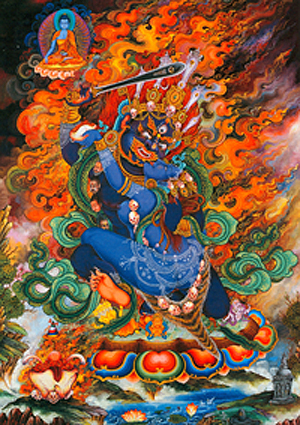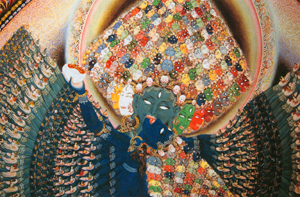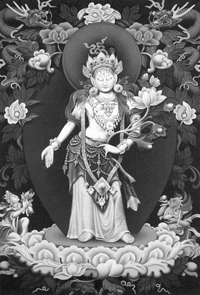For over a thousand years, Tibetan society steadily absorbed the artistic and cultural influences of neighboring lands, developing a unique artistic tradition that flourished until the Chinese invasion in 1959. Between the eighth and twelfth centuries, Tibet became the direct inheritor of the various Vajrayana traditions of India, which represented the ultimate flowering of Indian Buddhist culture. From its southern neighbors, Tibet took on the ancient artistic traditions of the Pala dynasty of eastern India and the ingenious skills of the Newar craftsmen of Nepal’s Kathmandu valley. From the west and north Tibet was exposed to the styles of Kashmir, Khotan, and central Asia, while from the east came the stylistic influences of Chinese art. Over the centuries the impact of this encircling ring of artistic diversity, with the enduring influences of the ornate Newar and spacious Chinese styles, gradually gave rise to the unique mode of expression that we now identify as “Tibetan art,” the most recognizable form of which is the thangka, or scroll painting.

One erroneous view commonly held in the West is that Tibetan thangkas are the work of copyists, who display little creative imagination or talent in their meticulous replication of previous works. This is not the case, for the continuity of such an old and highly esoteric artistic tradition inevitably gave rise to sparks of artistic genius in each generation, and there have been countless anonymous “divine artists” whose innovation and creative stature equal that of Raphael or Michelangelo. Another mistaken idea is that thangkas were traditionally painted by monks; in fact, they were usually painted by highly skilled and devout laymen whose knowledge of the iconography and symbolism of the vast pantheon of deities would stagger the mind of any Tibetan monk. Attaining the status of a master thangka painter takes many years of study, dedication, and practice under an accomplished master. With this attainment comes the confidence of one’s own unique creative vision within the vibrant context of a “lineage of transmission.”
Chairman Mao’s Red Guards understood nothing of this as they smashed and plundered their way through the devastating years of the Cultural Revolution. The ensuing decades of harsh religious and cultural suppression resulted in the abrupt severing of many of Tibet’s ancient lineages of transmission, with an entire generation of lamas, monks, scholars, and craftsmen being either persecuted and imprisoned or forced into exile on the Indian side of the Himalayas. With the first glimmer of liberalization and the opening of Tibet to foreign tourist groups during the mid-1980s, the Tibetans began to rebuild and restore some of the six thousand monasteries that had been either destroyed or desecrated. Sadly, only a small number of elderly thangka painters had survived to begin this work of restoration, and although their enthusiastic younger apprentices rapidly developed their own hereditary skills in the techniques of painting, the ability to accurately draw and understand the highly esoteric symbolism of the deities and their mandalas was not so easy to assimilate.

Most of the Tibetans who fled their homeland were resettled in the refugee camps of India and Nepal, but their impoverished conditions made the propagation of their artistic traditions difficult at best. The few thangka painters who managed to reestablish themselves in exile were dispersed thinly throughout the refugee settlements, and—with an increasing demand for commissions and insufficient financial patronage—these artists often had to produce works very quickly, thwarting their full artistic potential. The traditional standard—devoting a year or more to produce a single exquisite painting—was now rarely adhered to, and with the depletion of their stock of native mineral pigments and dyes, the artists often had to resort to synthetic Indian poster paints.
During the early 1970s the overland “hippie trail” from Europe to Asia culminated in the ancient temple city of Kathmandu; and, to meet a growing demand for esoteric souvenirs, the Nepali entrepreneurs of what was then called the “Freak Street” tourist area began to produce cheap artifacts such as ritual implements, erotic woodcarvings, and Tibetan thangkas. Although these thangkas were often touted as genuine articles painted in “stone color,” they were really the works of young Nepali painters who cunningly darkened the thangkas’ painted surfaces and brocade borders to make them look old. The iconography was egregiously inaccurate. These Buddha-filled compositions and mandalas are still available in Nepal at the cheap end of the market, where they can almost be bought by weight, but the sophistication of the market has improved.

With the availability of many beautifully illustrated books on Tibetan art and the proximity of color photocopiers, it is now quite easy to enlarge and trace an image onto a blank thangka canvas and fill in the colors. There are now over 5,000 Nepali artists working in the Kathmandu valley, and although they are very skillful copyists they invariably have little understanding of the complex subject matter they are depicting. The same holds true for the many dealers who own the thangka shops in Kathmandu, who generally display a regrettable lack of knowledge of Buddhist iconography. The demand for fascinating new compositions has also led to the production of many “hybrid thangkas,” where the lineage holders and deities of different Tibetan traditions are depicted in incongruous assemblies. The simpler peaceful deities are often painted quite accurately, but the renderings of the more complex meditational and protective deities are invariably riddled with errors. There is a thriving market for these paintings in countries like Taiwan, Japan, and even Tibet, where they are sold as authentic Tibetan thangkas.
Meanwhile, a modest revival of authentic Tibetan artistic tradition is under way. Some of the hereditary artistic lineages are now being reinstated in Tibet, and the Orient Foundation of Bath, England, is currently documenting for posterity the encyclopedic knowledge of Yeshe Sherab, one of the last surviving great old master painters of Tibet. In Dharamsala, the focal point for Tibetans in Indian exile, the thangka painting school of Thangde Gatsal was established in 2003, while in Boudhnath, near Kathmandu, a school at Shechen Monastery was founded.
The artistic legacy of Tibet’s close neighbor, Bhutan, remains largely intact, and the indigenous Newar artistic tradition of Kathmandu has undergone a vibrant revival over the last century, set in motion by the artistic genius of Anandamuni Sakya (1903—44) and his son Siddhimuni Sakya (1933—2001). Many extremely talented young Newar artists now follow in the footsteps of Anandamuni and Siddhimuni in their striving for artistic perfection, including Siddhimuni’s son, Surendra Man Sakya (born 1967), who is at present working on a painting of Vishvarupa Lokeshvara that will take six years to complete.
And what of the future? The transmission of Indian Buddhism into Tibet took place over a period of four hundred years, whereas the transmission of Tibetan Buddhism into the world at large has only just entered its fifth decade. From the quietude of its original monastic setting the teachings of the Vajrayana are now finding application in the turbulence of the modern world. Wherever Buddhism has traveled it has absorbed the cultural expression of each country in which it has taken root. Tibetan Buddhism, with its iconic art, impinges on the secular aestheticism of the West, it must inevitably pass through a period of experimental transition. Yet, as in the past, meaning will be found with time and increased understanding. The pure light forms of the Vajrayana deities encapsulate the entire spectrum of the Buddhist teachings within their complex symbolism. As visual archetypes of our own inner potential, they are destined to shine once again in mankind’s eternal quest for meaning.
Thank you for subscribing to Tricycle! As a nonprofit, we depend on readers like you to keep Buddhist teachings and practices widely available.